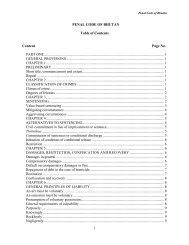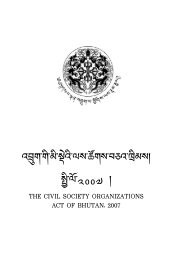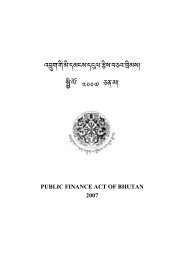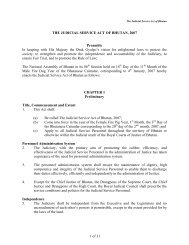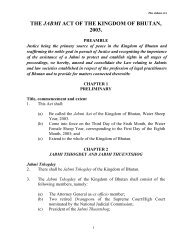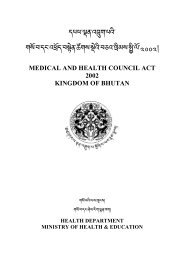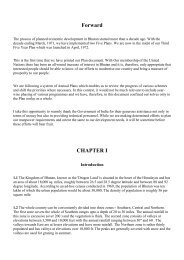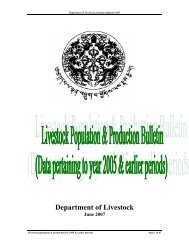journal of renewable natural resources bhutan - Ministry of Agriculture
journal of renewable natural resources bhutan - Ministry of Agriculture
journal of renewable natural resources bhutan - Ministry of Agriculture
- No tags were found...
Create successful ePaper yourself
Turn your PDF publications into a flip-book with our unique Google optimized e-Paper software.
Hindrances to enhance honey production are several. Lack <strong>of</strong> skills onimproved ways <strong>of</strong> beekeeping, periodic migration <strong>of</strong> bees due toseasonal temperature fluctuation, absconding due to food shortage,disturbance to colonies and pest attacks contribute negatively to honeyproduction. Action research needs to be carried out along with thebeekeepers to find ways to curtail migration/absconding and control <strong>of</strong>pest while imparting them skills on modern beekeeping practices.KEYWORDS :Honey bees, Apis cerena, log hives, foothillsINTRODUCTIONN. B. TamangFoothills in the sub-tropical belt <strong>of</strong> Bhutan are home for many species<strong>of</strong> honey bees such as Apis dorsata, Apis florea, Apis cerena and Apismelipona. Among these species Apis cerena and Apis melipona issuccessful hived for generations to produce honey.Honey produced is mostly consumed by family member at home anduse it for medicinal purpose to cure common ailments. Only somehousehold sell a few bottles as and when there are cash needs at home.Therefore, economic benefit from commercial honey production is yetto be exploited and realized.Owing to little <strong>resources</strong> required for beekeeping, improvement <strong>of</strong>traditional practices could increase honey production and it can be apotential economic activity for poor and landless people to generatecash income to alleviate rural poverty.Moreover, honey bees are increasingly recognized as an importantpollinating agent. Keeping bees is proven to increase yields and pr<strong>of</strong>itfrom crops substantially. For example, the economic value <strong>of</strong>pollination services in US on the 100 most significant crops isestimated at US$ 1.6-9.0 billion and in Costa Rica there had been 7%increase in c<strong>of</strong>fee production valued at $62,000(API, 2006). Further,Popa (1980) estimated that indirect contribution <strong>of</strong> honeybees toagricultural production is 10-15 times greater than direct contribution.26




